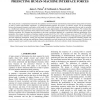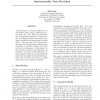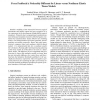BC
2002
13 years 4 months ago
2002
ACT This study presents a computational framework that capitalizes on known human neuromechanical characteristics during limb movements in order to predict man-machine interactions...
UAI
2001
13 years 5 months ago
2001
An instrument is a random variable that is uncorrelated with certain (unobserved) error terms and, thus, allows the identification of structural parameters in linear models. In no...
HAPTICS
2007
IEEE
13 years 10 months ago
2007
IEEE
Realistic modeling of the interaction between surgical instruments and human organs has been recognized as a key requirement in the development of high-fidelity surgical simulato...
CDC
2008
IEEE
13 years 10 months ago
2008
IEEE
— Protein synthesis is an essential process of cell cycle and growth in eukaryotic cells. The initiation stage of the translation process is known to be the most crucial in regul...
CVPR
2007
IEEE
14 years 6 months ago
2007
IEEE
We introduce novel discriminative learning algorithms for dynamical systems. Models such as Conditional Random Fields or Maximum Entropy Markov Models outperform the generative Hi...



